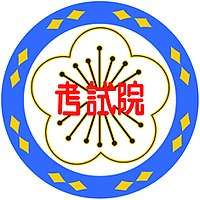District Courts (Taiwan)
| District Courts in Taiwan | |||||||||||||||||||||
| Chinese name | |||||||||||||||||||||
|---|---|---|---|---|---|---|---|---|---|---|---|---|---|---|---|---|---|---|---|---|---|
| Chinese | 地方法院 | ||||||||||||||||||||
| |||||||||||||||||||||
| Japanese name | |||||||||||||||||||||
| Kanji | 地方法院 | ||||||||||||||||||||
| Kana | ちほうほういん | ||||||||||||||||||||
| |||||||||||||||||||||
 |
|---|
| This article is part of a series on the politics and government of the Republic of China |
|
Leadership |

|
|
Other branches |
|
Related topics |
|
|
The District Courts (Chinese: 地方法院; pinyin: Dìfāng Fǎyuàn; Pe̍h-ōe-jī: Tē-hng Hoat-īⁿ) are the ordinary trial courts of general jurisdiction under the law of Taiwan. Currently there are 22 district courts under the jurisdiction of the Republic of China (Taiwan).
History
District courts (地方法院, chihō-hōin) were first established in Taiwan in 1896. The jurisdiction of the district courts changed several times in the Japanese era. There were five(5) district courts in Taiwan as of 1945, the end of the Japanese rule, when the courts were incorporated into the Republic of China court system.
| No. | Name | Japanese | Jurisdiction | Present division equivalent | |
|---|---|---|---|---|---|
| 1 | Taihoku District Court | 臺北地方法院 | Northern Taihoku Prefecture | Taipei, New Taipei, Keelung | |
| Giran Branch | 宜蘭支部 | Southern Taihoku Prefecture | Yilan | ||
| Karenkō Branch | 花蓮港支部 | Karenkō Prefecture, Taitō Prefecture | Hualien, Taitung | ||
| 2 | Shinchiku District Court | 新竹地方法院 | Shinchiku Prefecture | Taoyuan, Hsinchu city/county, Miaoli | |
| 3 | Taichū District Court | 臺中地方法院 | Taichū Prefecture | Taichung, Changhua, Nantou | |
| 4 | Tainan District Court | 臺南地方法院 | Southern Tainan Prefecture | Tainan | |
| Kagi Branch | 嘉義支部 | Northern Tainan Prefecture | Chiayi city/county, Yunlin | ||
| 5 | Takao District Court | 高雄地方法院 | Takao Prefecture, Hōko Prefecture | Kaohsiung, Pingtung, Penghu | |
Note that the Empire of Japan was granted extraterritoriality in China from late 19th century until World War II. During this time, Taihoku District Court also handled the trial cases regarding Japanese citizens (including Taiwanese and Korean) in the Chinese provinces of Fujian, Guangdong and Yunnan.
After World War II, more district courts were established as the population growth. The newest district court, Ciaotou District Court, was established in September 2016 in Kaohsiung.[1] This makes the total count of district courts in Taiwan to 22.
List of District Courts
There are currently 20 district courts under the jurisdiction of the Taiwan High Court and 2 district courts under the jurisdiction of the Fuchien High Court[2]. The Kinmen and Matsu district courts are under the jurisdiction of the Fuchien High Courts as those counties are part of Fujian Province, Republic of China and not historically part of Taiwan Province. The jurisdictions of district courts do not always follow the boundary of the administrative divisions.[3]
| No. | Name | Chinese | Jurisdiction | No. | Name | Chinese | Jurisdiction | |
|---|---|---|---|---|---|---|---|---|
| 1 | Changhua | 臺灣彰化地方法院 | Changhua County | 12 | New Taipei | 臺灣新北地方法院 | Western New Taipei | |
| 2 | Chiayi | 臺灣嘉義地方法院 | Chiayi, Chiayi County | 13 | Penghu | 臺灣澎湖地方法院 | Penghu County | |
| 3 | Ciaotou | 臺灣橋頭地方法院 | Northern Kaohsiung | 14 | Shilin | 臺灣士林地方法院 | Northern Taipei and northern New Taipei | |
| 4 | Hsinchu | 臺灣新竹地方法院 | Hsinchu, Hsinchu County | 15 | Pingtung | 臺灣屏東地方法院 | Pingtung County | |
| 5 | Hualien | 臺灣花蓮地方法院 | Hualien County | 16 | Taichung | 臺灣臺中地方法院 | Taichung | |
| 6 | Kaohsiung | 臺灣高雄地方法院 | Southern Kaohsiung | 17 | Tainan | 臺灣臺南地方法院 | Tainan | |
| 7 | Keelung | 臺灣基隆地方法院 | Keelung and eastern New Taipei | 18 | Taipei | 臺灣臺北地方法院 | Southern Taipei and southern New Taipei | |
| 8 | Kinmen | 福建金門地方法院 | Kinmen County | 19 | Taitung | 臺灣臺東地方法院 | Taitung County | |
| 9 | Lienchiang | 福建連江地方法院 | Lienchiang County (Matsu Islands) | 20 | Taoyuan | 臺灣桃園地方法院 | Taoyuan City | |
| 10 | Miaoli | 臺灣苗栗地方法院 | Miaoli County | 21 | Yilan | 臺灣宜蘭地方法院 | Yilan County | |
| 11 | Nantou | 臺灣南投地方法院 | Nantou County | 22 | Yunlin | 臺灣雲林地方法院 | Yunlin County |
Divisions
Each District Court may establish summary division for different regions under it, for the adjudication of cases suitable for summary judgment and small claims cases. The civil summary procedure is for cases involving an amount in controversy of not more than 500,000 New Taiwan dollars[4] and for simple legal disputes.[2] The small claims cases are cases demanding payment for less than 100,000 NTD.[5] Currently there are a total of 45 divisions in Taiwan.[2] Additionally, there is a Taiwan Kaohsiung Juvenile Court, established in accordance with the Law Governing the Disposition of Juvenile Cases.[2]
Each of the District Courts has civil, criminal and summary division and may establish specialized divisions to handle cases involving juveniles, family, traffic, and labor matters as well as motions to set aside rulings on violations of the Statute for the Maintenance of Social Order.[2] Each division has a Division Chief Judge who supervises and assigns the business of the division. Each District Court has a Public Defenders' Office and a Probation Officers' Office.[2]
Judges
A single judge hears and decides cases in ordinary and summary proceedings as well as in small claims cases.[2] A panel of three judges decides cases of great importance in ordinary proceedings as well as appeals or interlocutory appeals from the summary and small claims proceedings.[2] Criminal cases are decided by a panel of three judges, with the exception of summary proceedings which may be held by a single judge.[2] The Juvenile Court hears and decides only cases involving juveniles.[2]
Jurisdiction
District Courts have jurisdiction over the following cases:[2]
- Ordinary or summary civil and criminal cases as well as civil small claim cases as courts of the first instance;
- Civil and criminal appeals or interlocutory appeals from decisions rendered by the summary divisions;
- Juvenile matters;
- Family matters;
- Traffic cases;
- Civil compulsory execution cases;
- Non-contentious matters;
- Civil protection writs;
- Rehabilitation of delinquents;
- Labor-management disputes;
- Elections and recalls;
- Violations of the Statute for the Maintenance of Social Order;
- Other cases prescribed by law.
Dispute
On 31 March 2017, Taipei District Court finished a judgment of first instance, this is the first time, the collegial court invoked the concept of "civil disobedience", and Identify the motive and purpose of the protest act, are related to public affair. They said the people of Sunflower Movement (As Huang Kuo-chang, Lin Fei-Fan, Chen Wei-ting,and related people) all are innocent.
See also
Gallery
 Taiwan Changhua District Court
Taiwan Changhua District Court Taiwan Chiayi District Court
Taiwan Chiayi District Court- Taiwan Hsinchu District Court
 Taiwan Hualien District Court
Taiwan Hualien District Court- Taiwan Kaohsiung District Court
- Taiwan Pingtung District Court
 Taiwan Shilin District Court
Taiwan Shilin District Court- Taiwan Tainan District Court
- Taiwan Taipei District Court
 Taiwan Taoyuan District Court
Taiwan Taoyuan District Court- Taiwan Yilan District Court
References
- ↑ Ciaotou District Court
- 1 2 3 4 5 6 7 8 9 10 11 See, Taipei District Court, About Us - Organization, http://www.judicial.gov.tw/en/english/branches/branch.asp (last visited Mar. 28, 2012)
- ↑ Directory of the Judicial Branch
- ↑ Article 427 of the Code of Civil Procedure.
- ↑ Article 436-8 of the Code of Civil Procedure.


